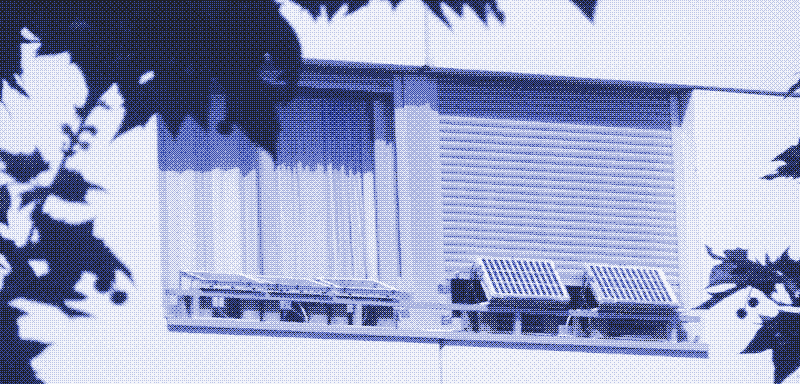
The typical solar PV power installation requires access to a private roof and a big budget. However, wouldn’t it be possible to get around these obstacles by installing small solar panels on window sills and balconies, connected to a low-voltage direct current (DC) distribution network? To put this theory to the test, I decided to power Low-tech Magazine’s home office in Spain with solar energy, and write my articles off the grid.
Solar panels have become cheaper and more efficient in recent years, but they are far from a universal solution, even in sunny regions. One reason is that a typical solar photovoltaic (PV) installation is still beyond the budget of many people. The average pricing for a 5kW residential PV system completed in 2014 varied from $11,000 in Germany to $16,450 in the USA. 12 Roughly half of that amount concerns the installation costs. 3
A second obstacle for solar power is that not everybody lives in a single-family dwelling with access to a private roof. Those who reside in apartment buildings have little chance of harvesting solar power with a conventional roof-mounted system. Furthermore, in apartment buildings, the roof would quickly become too crowded to cover the electricity use of all residents, a problem that grows larger the more floors there are in a building. Lastly, a typical solar installation is problematic when you’re renting a place, whether it’s a house or an apartment.
I’m one of those people who runs into every one of these obstacles: I live in a flat, I rent the place, and I don’t have the budget for a conventional solar system. However, I receive a lot of sunshine. My apartment is located near Barcelona in Spain, a city with an average solar insolation of almost 1,700 kWh/m2/year (which is also the average figure across the USA). Furthermore, the 60 m2 apartment has the balcony and all windows facing south-south-west, and there is no shading by trees or other buildings.

These conditions allow me to get through the winter without a heating system, relying only on solar heat and thermal underclothing. Hot water is supplied by a solar boiler, which was installed by the landlord. Clothes are dried on the balcony. While tinkering with solar panels for an art project, I got an idea: with the sun already powering so much of my living space, wouldn’t it also be possible to harvest solar power from the window sills and the balcony and take my apartment off the electricity grid? Such a PV installation would solve my problems:
- I don’t need access to the roof.
- I can install the system myself, which makes it much cheaper.
- I can take the solar installation with me if I move to another place.
Obviously, the big question is whether or not such an unconventional solar system could generate the necessary electricity. As a first experiment, I decided to power my 10 m2 home office with solar panels placed on the 2.8 m long window ledge that runs along the windows of the office and the adjacent bedroom.
Solar Powered Home Office
The window in my office is quite small (at 1.5 m2, it takes up only half of one wall). However, there’s no need for power in the bedroom, which has been lighted by three IKEA SUNNAN lamps for years. Consequently, the full window ledge is available to power the home office. It offers enough space for five solar panels of 10W each, providing me with 50 watt-peak of solar power. The balcony will serve to power the rest of the apartment, and the plans for that second project are outlined at the end of this article.

With their placement on the window sill, the panels are shaded by the building itself in the morning. They receive direct sunlight from about 10 am to 5 pm in the pit of winter (a total of 7 hours), and from roughly 1 pm to 9 pm in the height of summer (a total of 8 hours). The maximum energy production is thus roughly 400 Wh per day.
The solar panels are connected in parallel and coupled to a solar charge controller and 550 Wh of lead-acid batteries. Assuming a 33% Depth-Of-Discharge (DoD) and a round-trip battery efficiency of 80%, this gives me a maximum energy storage of roughly 150 Wh.
Can you power a home office with 50 watt-peak solar panels and 150 Wh of energy storage?
Now let’s look at the energy use of my home office, before it was solar powered. I sit here working most of the days, either researching, writing, or building and repairing stuff. Devices that regularly use electricity are:
- A laptop, which requires an average 20 watts of power.
- An external computer screen, which needs 16.5W of power.
- Two CFL lamps (20W and 12W) and one LED-lamp (3W).
Home Office Power Use
This adds up to 35W of power during the day (with only the laptop and the screen in use) and 70W after sunset (the laptop, the screen, and the lights). I usually work in the mornings and evenings, roughly from 10 am to 2 pm and from 8 pm to 1 am. During the afternoon, I do other stuff or I work in the library.
Total electricity use in my office is thus (on average) 500 Wh per day, with little variation between winter and summer. On cloudy days I also use lights in morning, which can raise energy use to 640 Wh per day. Then there are some devices that occasionaly need power:
- A laser printer, which uses 4Wh of energy for warming up and printing eight text pages. This corresponds to operating my desk lamp (5W) for more than 45 minutes. A pair of PC loudspeakers (1.5W of power).
- Three USB bicycle lights (each use 1.4W of power while charging).
- A digital camera, which uses 3W while charging.
- A fan, which uses 30-40 watts of power.
- A mobile phone (a dumb one) that’s charged once every few weeks.
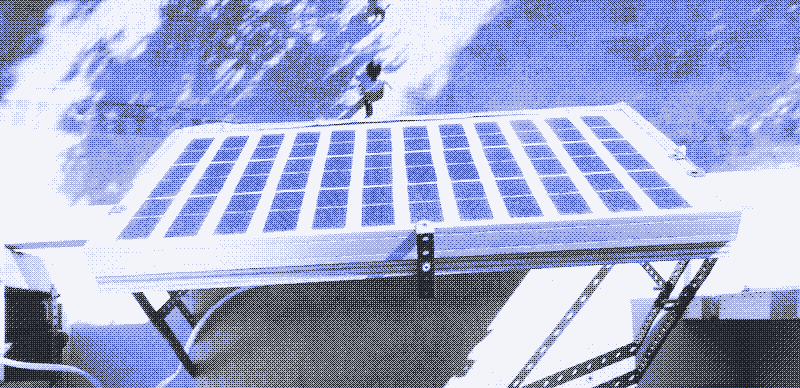
Obviously, my solar PV system doesn’t produce enough energy to power my home office. While regular electricity use is at least 500 Wh on a 9-hour working day, the window sills give me a maximum of 400 Wh per day. On overcast days, energy production can be as low as 40 to 200 Wh per day, depending on the type of cloud cover. Furthermore, energy storage is only 150 Wh under ideal circumstances, while most energy use (350 Wh) is after sunset.
And yet, here I am, typing this article on a solar powered laptop in a room that’s lit by solar power. How is this possible? By following these strategies:
- Maximize solar power production by tilting the panels according to the season.
- Minimize power use by installing a low-voltage DC grid and using DC appliances.
- Force yourself to lower energy demand on dark days by going off the grid.
Below, we look at these points in more detail. My solar system has been in operation since November 2015, initially with only two 10W panels. Three more panels were added in early spring.
1. Adjust the Tilt of the Solar Panels
Roof-mounted solar panels usually have a fixed angle in relation to the sun. Because the elevation of the sun varies throughout the year, a fixed angle is always a compromise. Panels that lay horizontal on a flat roof are relatively well positioned for energy production in summer, but much less so for use in winter. On the other hand, tilted solar panels perform much better in winter but not as well as in summer. On sloped roofs, the angle of the panels is often determined by the angle of the roof, which isn’t necessarily the best angle for solar power production.
A PV panel that’s optimally tilted towards the winter sun can triple electricity generation compared to a horizontally placed panel
Adjusting the angle of a solar panel according to the season can increase electricity production significantly in winter. In December, a PV panel in Barcelona that’s optimally tilted towards the winter sun can triple electricity generation compared to a horizontally placed panel. Because the advantage is much smaller in other seasons, the average annual increase in power production is less than 10%. However, tilting the panels is the key to harvesting enough solar power during the winter months, when power shortages are most probable.
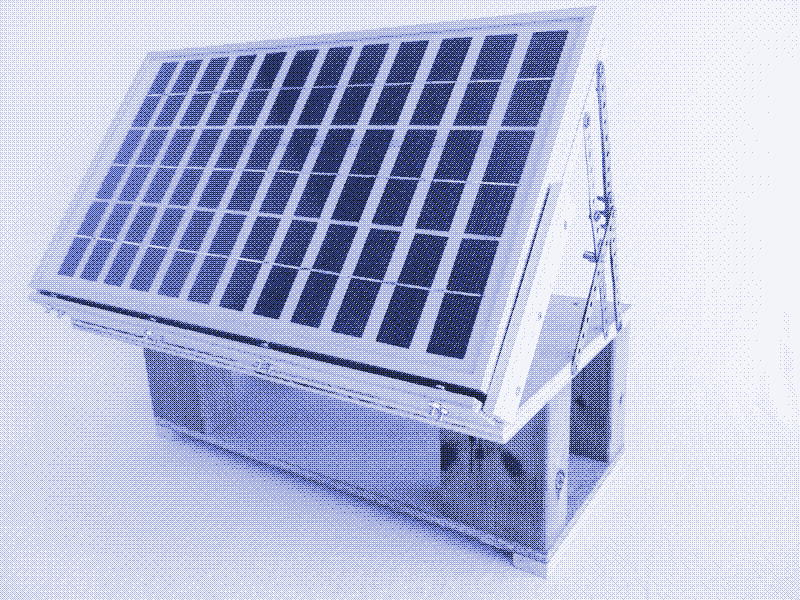
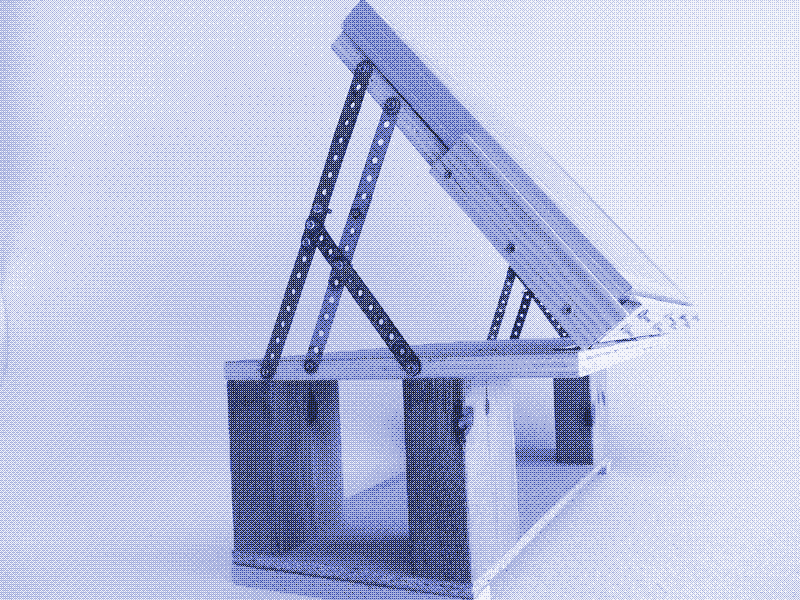
In the case of a balcony or window sill solar PV system, adjusting the angle of the solar panels is as simple as watering the plants. Although you could make small adjustments every hour, day or month, adapting the angle two or four times per year is as far as you should go.
There’s another advantage to having the solar panels so close at hand: they can be cleaned regularly. Roof-mounted solar panels rarely get cleaned because the roof usually isn’t very accessible. Losses due to dust and dirt are assumed to be 1% of generated energy, but in dry and dusty regions, as well as in traffic-heavy areas, they can be as high as 4-6% if washing is not undertaken on a regular basis. 4
Adjusting the angle of a window sill solar panel is as simple as watering the plants
Obviously, it’s crucial that the panels don’t fall off the window ledge, no matter what happens. Window sills differ in shapes and sizes, which calls for a custom-made supporting structure. I have a fixed metal bar at my window sill, aimed at protecting plant containers, which allows me to securely lock the solar panels in place. I guess I’m lucky to have this, but it also shows how small design changes can make a big difference. As an additional safety measure, I loaded the wooden base of each panel with some heavy rocks.
Adding a mechanism to vary the tilt of the panels complicates the design, because the moving part has to be just as sturdy as the base. Following some failed attempts, I found a mechanism that seems to work, using vintage Meccano rods (2-3 layers thick and with larger nuts and bolts). One rod is connected to the base of the structure, while another is connected to the wooden board that carries the panel. Both rods are connected to each other in the middle. Loosening this connection allows me to adjust the length of the supports and thus the angle of the solar panels.
Solar PV Windows?
Some readers might consider my approach soon-to-be-obsolete, because several companies are working on “solar PV windows”: glass that doubles as an electricity generator. However, this technology would not perform as well as adjustable solar panels on window sills, for several reasons.
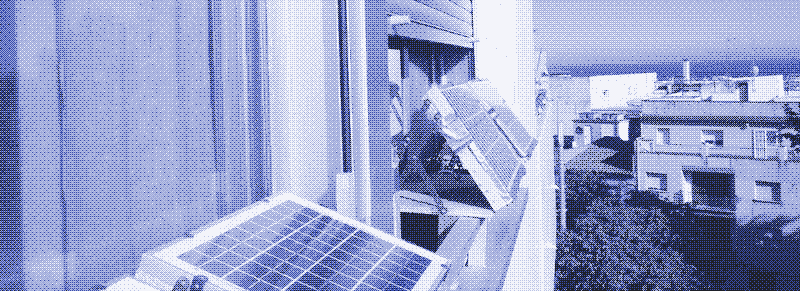
First of all, solar PV windows are most often entirely vertical, which is never an efficient angle to generate solar power — their power generation is about 3 times lower than horizontal panels. 5 Secondly, in summer it would be impossible to open the windows or lower the shutters, which would quickly overheat my office and introduce a need for air-conditioning.
My solar PV installation, on the other hand, can produce power when the shutters are closed and when the windows are open. Last but not least, a window-integrated solar panel can’t be taken with you when you move, while my system is entirely mobile.
2. Opt for a Low-Voltage DC System
Typical solar PV systems convert the direct current (DC) electricity produced by solar panels into alternating current (AC) in order to make it compatible with the AC distribution system in a building. Because many modern appliances operate internally on DC, the AC electricity is then converted back to DC. The DC/AC-conversion is done by an inverter, which sits between the solar charge controller and the load. The second conversion happens in the (external or internal) AC/DC adapter of the devices that are being used.
The trouble with this double energy conversion is that it generates substantial energy losses. This is especially true in the case of solid-state devices such as LEDs and computers, where the combined losses of the DC/AC/DC conversion amount to roughly 30% — see our previous article for further detail. Because these are also the devices that make up most of the load in my home office, it makes a lot of sense to avoid these losses by building a low-voltage DC system instead.
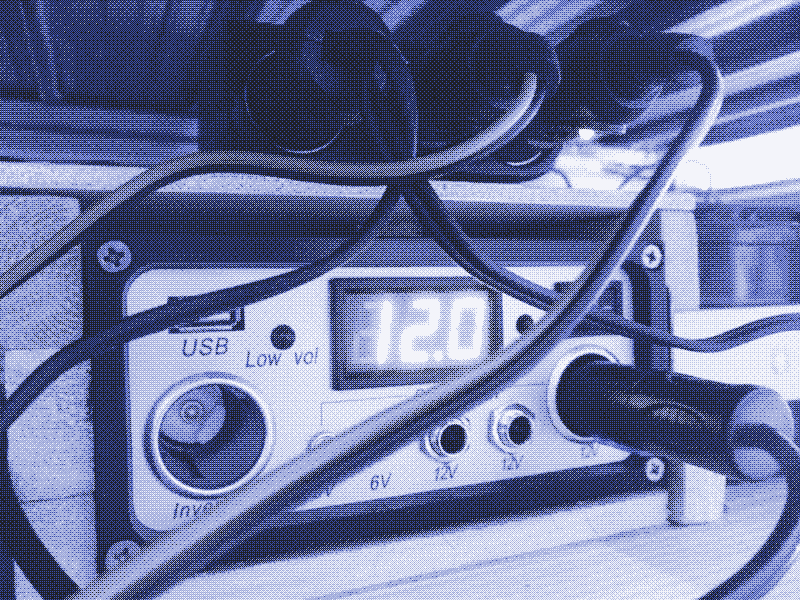
Like in a boat or a camper, the 12V DC electricity of my solar panels is used directly by 12V DC appliances, or stored in 12V DC batteries. If my solar panels generate their maximum output of 50W, my devices have 50W available. When battery power is involved, charging and discharging the battery adds 20% of energy loss, which leaves 40W available for the appliances.
The choice for a low voltage DC system raises energy efficiency by 40%
On the other hand, in a typical solar PV installation where a DC/AC/DC energy conversion takes place, the devices would only have 35W available, and the rest would be lost as heat during energy conversion. If lead-acid battery storage is used in such a system, only 28W of power remains. In short, in my specific case, choosing a DC system multiplies power production by 1.4 times.
The choice for a DC system saves not only energy but also space and costs. Less solar panels are needed and there’s no need to buy a DC/AC inverter, which is a costly device that needs to be replaced at least once during the life of a solar system. Most importantly, you can build a DC solar power system yourself, even if you’re as clumsy as I am. A low-voltage DC grid (up to 24V) is safe to handle because it carries no risk of electric shock. 6 Adding up all costs, I took my home office off the grid for less than 400 euro.
Where to Find DC Appliances
Mounting a DC system implies the use of DC-compatible devices. However, because so many modern appliances operate internally on DC, this doesn’t mean that you have to buy everything anew. To adapt the lighting in my office, I simply cut the mains plugs from the power cords, replaced them with DC-compatible plugs that fit straight into my solar charge controller, and substituted the light bulbs with 12V LED-bulbs. To run the laptop on DC, I replaced the power adapter by a DC-compatible power cord, which is available for use in cars. These power cords can be bought for every laptop model you can imagine.
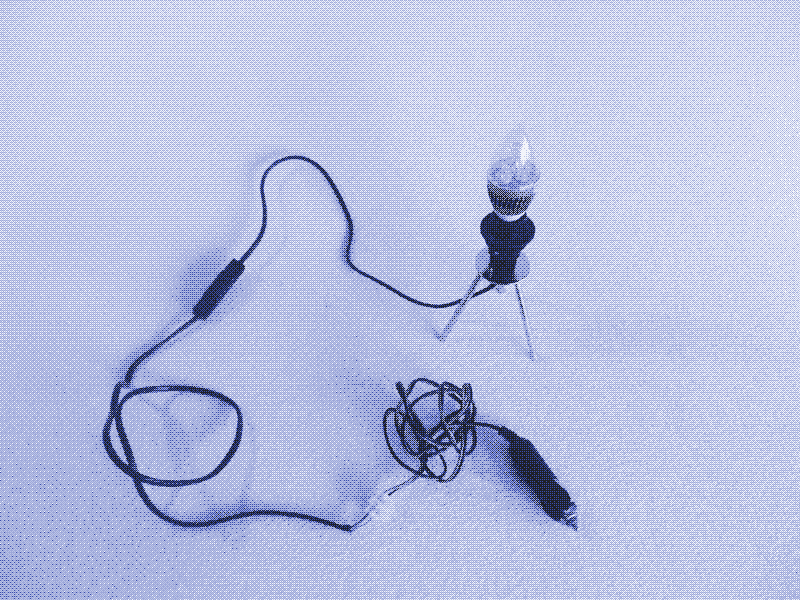
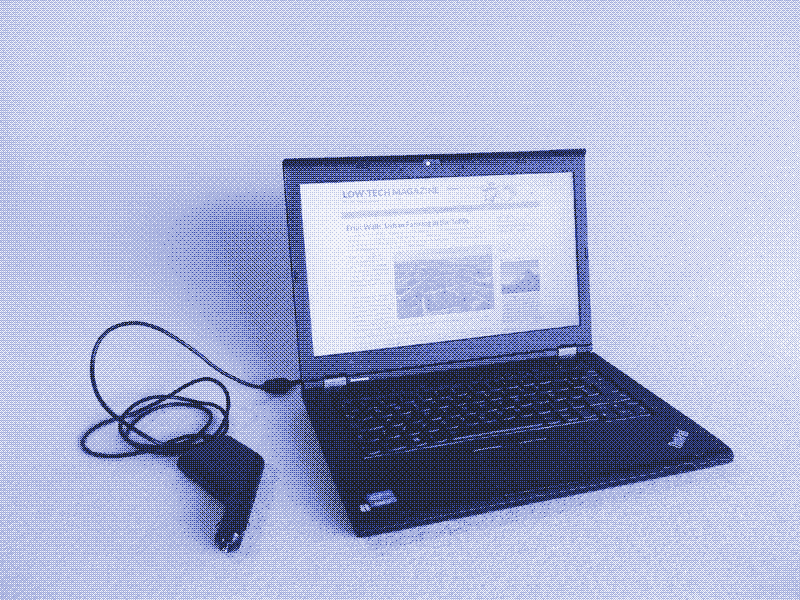
Other devices are harder to adapt because the AC/DC adapter is located in the device itself. For example, I haven’t figured out yet how to convert my external computer screen to operate directly on DC power.
Appliances that cannot be converted are usually available in a 12V DC version. Examples are refrigerators, slow cookers, televisions, air compressors, or power tools. These can be more expensive than their AC counterparts, because they are produced in much smaller quantities. DC refrigerators are very expensive because they use vacuum insulation. While this makes sense in a camper or sailboat where space is restricted, it’s a needless cost in a common building.
The cigarette lighter receptacle in cars, initially designed to power an electrically heated cigarette lighter, has been the de facto standard DC connector for decades. More recently, it has been joined by another low voltage DC distribution system, the USB connector. USB cables operate on 5V DC and can transfer both data and energy. Many consumer electronics are now powered by them.
Currently, these devices are charged by the USB-port of a laptop or desktop computer, but they could be plugged straight into a solar PV system. While the standard USB-cable carries a maximum power of only 10 watts, the newer USB-PD standard accommodates devices with a power consumption of up to 100 watts.
Overcast Days
The choice for a DC system has lowered power consumption in my home office considerably. My laptop’s energy use has decreased by about 20%. Switching to DC-direct LED-lamps has halved power use for lighting from 35 to 16W. Based on the 9-hour working day described earlier, daily energy use of regularly used devices in my home office has come down from 500 to 350 Wh/day. This brings average energy use below energy production on sunny days (400 Wh), which are plentiful where I live.
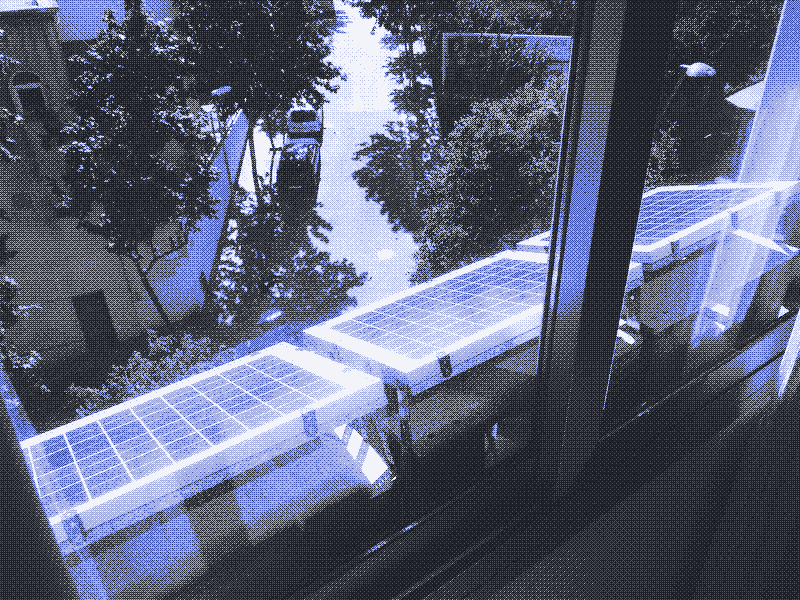
In reality, the external computer screen and the laser printer are still running on grid power. The 350 Wh of energy use mentioned above includes the hypothetical use of a DC external screen (saving 15% of power compared to the AC version), but not the energy use of the printer. However, on sunny days, I have a significant surplus of electricity, which suggests that I could also operate the external screen and the printer. Even on partly cloudy days energy is abundant.
However, energy use remains too high during overcast days, when power production is between 40 and 200 Wh per day. Obviously, adding more solar panels and batteries would solve the issue, but that’s not the way to go because the solar PV system would become more expensive, less practical, and less sustainable.
On sunny or partly cloudy days, I have more than enough electricity. On overcast days, I have to reduce energy demand.
To guarantee a daily 350 Wh of electricity during three consecutive heavy overcast days in December (a worst case scenario of only 40 Wh energy production per day), I would need to increase solar power capacity fourfold, from 50 to 200W peak capacity, and provide at least five times more batteries.
Although it would be possible to install 200W on the window sills, in that case the solar panels would stop solar light and heat from entering the rooms, which would be counterproductive. Furthermore, I would produce way too much electricity for most of the year.
3. Adjust Energy Demand to Meet Available Supply
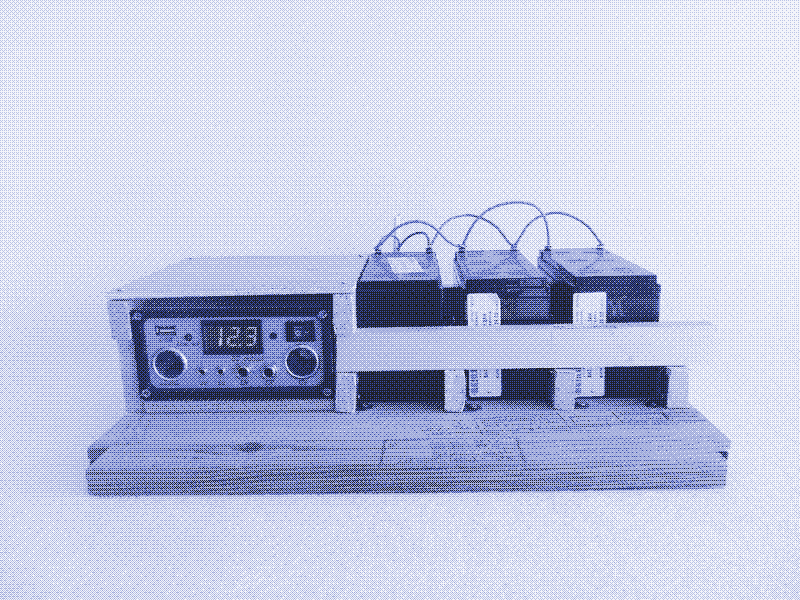
There’s another option to make the numbers match if there’s not enough sun available, and that’s using less energy. Suggesting a reduction in energy use is rather controversial, but there are a surprisingly large number of ways to reduce energy use, without having to revert to a typewriter and candles. Here are some possibilities for my home office:
- I could install a second working desk right next to the window. This eliminates the need for artificial lighting on dark winter days, which saves me at least another 40 Wh on days that electricity production is at its lowest.
- I could use less lights in evening during low solar power days. For most of the year, I have sufficient energy available to use all the lights in the room. However, most of the days I get by with only two lamps, and if necessary I could use a single 5W or even 3W lamp. When solar production is at its lowest, the latter still gives me more than 13 hours of light. I will never have to spend a night in the dark.
- I could shift loads towards sunny afternoons. Even in winter, the batteries can already be fully charged by around 2 or 3 pm on sunny days. Adding extra load to the system during these periods takes advantage of solar energy that would otherwise get wasted. This is when I can charge the bicycle lights, the digital camera or the phone, or when I can use the 12V soldering iron (my only power tool) or the printer. In summer I can use the surplus of energy to power two small USB-fans, and of course that’s the time when I need the fans the most.
There are a surprisingly large number of ways to reduce energy use, without having to revert to a typewriter and candles
- I could change my working schedule. If I could manage to work from 9 am to 6 pm instead of in morning and evening, I obtain a double energy savings. I would need no more lighting, except for one hour or so in winter (which saves 70 to 80 Wh/day). Secondly, I would use more electricity while it’s being generated, avoiding 20% battery charging and discharging losses while operating the laptop at night and in mornings (which saves another 30Wh). Changing my working schedule would lower daily electricity use to roughly 125Wh, less than half of maximum power production. Furthermore, all battery capacity would be available for overcast days, because there is no energy use at night.
- I could adapt computer work to solar conditions. There’s a remarkable difference in power use for the laptop between writing (roughly 15W) and surfing the web (roughly 25W). In other words, I can work almost twice as long when I’m writing, which I could do whenever available energy is low.
- I could ditch my external computer screen. It can be very handy for some work, giving both a screen to read and a screen to write, but most of the time it’s just wasting energy without being very useful. Ditching the external screen would save me another 150 Wh per day. However, it would probably increase the use of the printer, so it remains to be seen if this option really saves energy.
- During consecutive, heavy overcast days, I could revert to more drastic measures, like working in the library or not working at all. Or, I could do work that doesn’t involve any energy use during the day, such as reading books and taking notes by hand. This would bring extra advantages; it can be refreshing to disconnect and concentrate on something in the old-fashioned way. Going out one evening is a fun and easy way to keep the power level high enough during periods of bad weather.
- I could build a pedal powered generator for when I really need more electricity during overcast days. Strictly speaking, this is not a reduction of energy demand, but of course it implies an effort from my side. Pedalling for 1 to 1.5 hours would generate roughly 100 Wh of electricity, which would allow me to work on the computer for 3 to 5 hours, or to operate the 5W LED-light throughout the night.
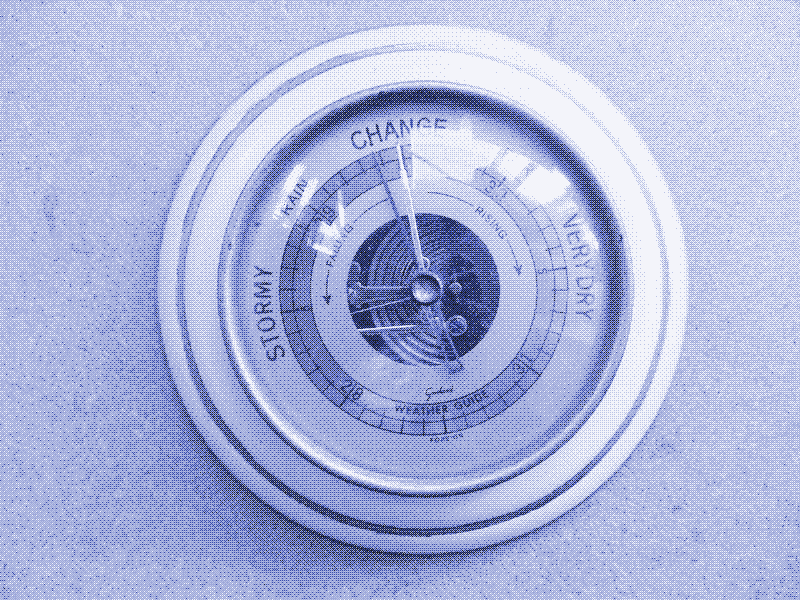
By keeping an eye on my barometer and being a bit flexible, it’s not that hard to plan work according to the weather. However, until now I managed to take advantage of these opportunities mostly when it comes to lighting, and less so when using the laptop. This has nothing to do with computer use being less flexible than lighting. Rather, it’s a consequence of how the system is built.
This became clear due to the rather clumsy way that I set up my experiment. Obviously, I wanted to test the installation in the depth of winter before writing about it. However, I only had two solar panels at the time. Therefore, I first tested my solar powered home office by running the laptop on solar energy for two weeks (while running the lights on grid power), followed by a two-week test of running the lights on solar energy (and the computer on grid power).
For lighting, it’s impossible to fall back on grid power because I had to cut the power cords of all lamps to make them compatible with the 12V DC grid
The results were remarkably different for both periods. With the laptop, I could always fall back on grid power by simply switching the power cord. Consequently, there were no external factors that forced me to change my way of working in order to remain within the limits of the energy budget on a dark day. For lighting, however, it was impossible to fall back on grid power. I had to cut the power cords of all lamps to make them compatible with the 12V DC grid, which meant that I could not run them on AC grid power anymore.
During low power periods, I had no other choice than to lower energy demand for lighting, and that’s exactly what I did, quite effortlessly I must say. I quickly made an extra desk at the window to avoid using artificial lights in morning, I switched the lights off whenever I left the room, and I worked with just a 5W or even a 3W light bulb if necessary.
Five months later, I have become totally accustomed to adjusting light levels to available solar power. On the other hand, I keep plugging my laptop into the grid if energy runs low. Why? Because I can. 7
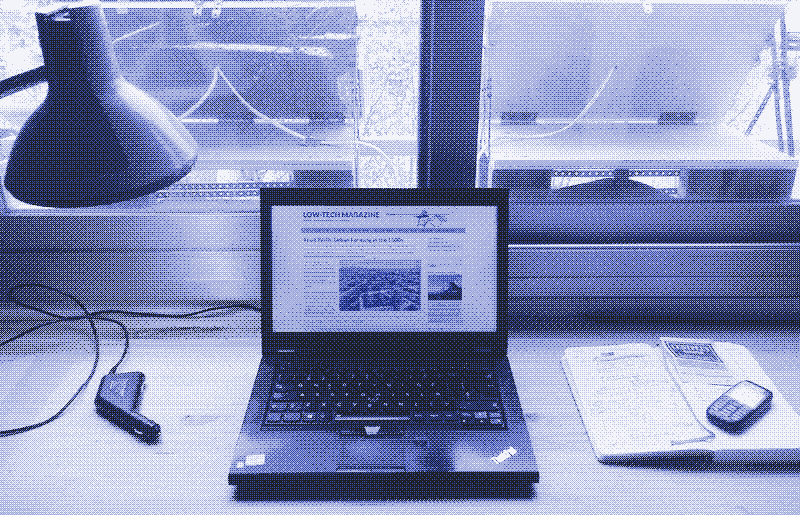
Consequently, going off-grid seems to be the key to lowering energy demand considerably. 8 Having a limited energy supply also encourages the use of more energy efficient technology. For example, the energy savings I made by replacing the two remaining CFL lamps by LEDs could also have been achieved without building a solar PV system. However, the option only occurred to me after I took up the challenge of powering the office with solar energy.
Progress in energy efficient technology will steadily increase the possibilities of my off-grid system, with no risks of rebound effects
If I would not be able to fall back on grid power, I would probably also get a more energy efficient laptop. 9 In the future, I could also switch to lithium-ion batteries, which have lower losses than lead-acid batteries. Investing in more energy efficient technology would allow me to run the computer and the lights longer with the same amount of solar panels. With a limited power supply, there’s no risk of rebound effects that negate these benefits.
Build Multiple Solar PV Systems
As mentioned at the beginning of the article, the solar powered home office is only the first step towards converting the whole apartment to solar power and going totally off-grid. The second project will be the installation of a solar system on the 6-metre long balcony in front of the living room and the (open) kitchen. It will power the lights, the stereo-installation, the Wifi-router, all computer use outside the office, and all kitchen appliances.
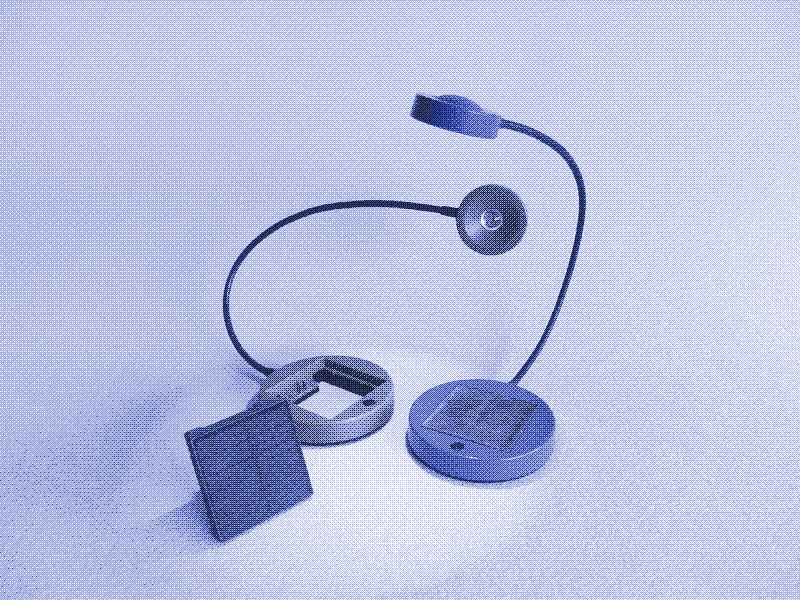
This second experiment is much more challenging for two reasons. First, the living room and kitchen will also be used by the second person in this household, which will make it more complicated to manage energy use. Furthermore, although we don’t have a toaster, a coffeemaker, or a microwave, the kitchen houses a much used high power appliance: the electric cookstove.
Because it would take too many solar panels and batteries to power the electric cookstove by solar PV panels, the plan is to replace it by non-electric alternatives: one or two solar cookers, a fireless cooker, and a rocket stove for the morning coffee. By using direct solar heat, we can make much more efficient use of the space on the balcony. Another plan is to build a low-tech food storage system that can store most of the food outside the refrigerator, keeping this energy-intensive appliance as small as possible or eliminating it altogether.
The balcony solar PV system will be totally independent of the window sill solar PV system
The balcony solar PV system will be totally independent of the window sill solar PV system. There are several advantages to this approach. As we have seen in the previous article, cable losses are relatively high in a low-voltage DC system. Setting up several independent systems greatly limits cable length (and cable clutter).
Secondly, installing separate systems allows total power use to surpass 150 watts — which is the safety limit for a 12V DC system. Thirdly, multiple systems make it possible to start small and gradually expand the system. This avoids large upfront costs and allows you to learn from your mistakes.
Learning from your Mistakes
In fact, it was one such mistake that made me decide to install two separate systems even in my relatively small 10 m2 home office. The two solar panels in front of the office are connected to half of the batteries (powering the lights), while the three solar panels in front of the bedroom are connected to the other half (powering the laptop).
This is because I short-circuited my first solar charge controller and had to buy a second one while the first one was being repaired. It was that or go without lights for three weeks. Thus, a final advantage of multiple systems is increased reliability: if one system fails, there is still electricity.
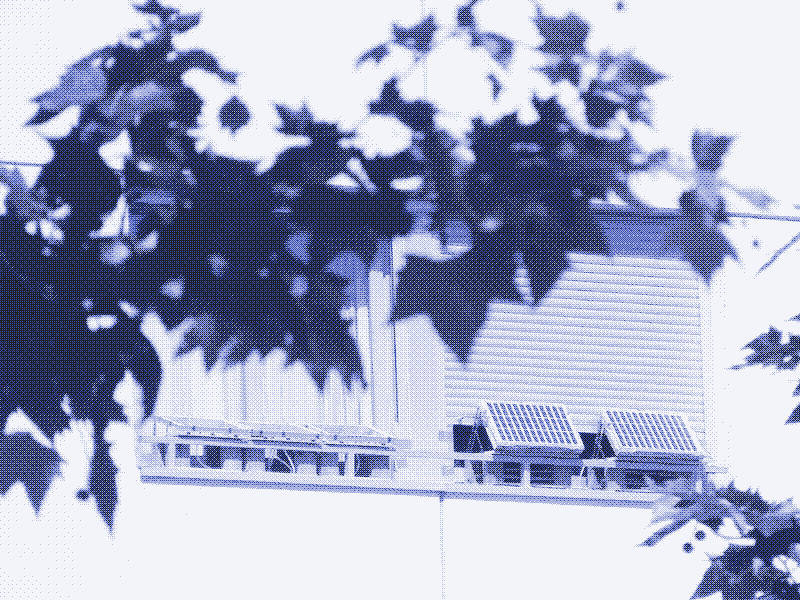
If the second experiment succeeds, and of course this remains to be seen, the plan is to stop the contract with our power provider, which is to be renewed in December. Obviously, it would be handy to keep a connection to the grid, but there are two important reasons not to do this. The first has been outlined above: going off-grid unleashes the creativity and willingness to lower energy demand.
Secondly, installing a solar system and holding on to a grid connection is financially disadvantageous. At least here in Spain, more than two-thirds of the electricity bill consists of fixed costs. Even if we would use much less grid electricity because of the solar system, our bill would remain more or less the same.
If the second experiment succeeds, and of course this remains to be seen, the plan is to stop the contract with our power provider
Some important challenges remain, most notably the washing machine, the bathroom and the laser printer. The problem with washing machine and bathroom is that they’re on the north side of the building, far from the solar panels. We could go to a laundromat but there are none in town. A pedal powered washing machine requires space that we don’t have.
The laser printer could be operated with an inverter, which can also be handy to power any other occasional device that doesn’t run on 12V DC power. However, a relatively large and expensive inverter would be needed, because the startup power of the machine is above 400 watts. Luckily, I found that out before I fried another costly device.
Before You Start
There are some things to keep in mind before you decide to install a low-tech solar PV system:
- You need enough sun. Solar panels on balconies and window ledges won’t work everywhere. A similar system like mine, but 1,000 km further up north, would produce on average only half the electricity, with a much larger difference between winter and summer.
- You need the right exposure. Even if you’re in a sunny climate, don’t think of harvesting solar power if windows or balconies are oriented towards the north, the northwest, or the northeast. Shading by other buildings or trees can also smother your ambitions. You need at least 4 hours of direct sunshine on the panels each day.
- You need to be prepared to lower your energy use. Few apartment dwellers will have enough space available to generate sufficient solar power for an energy-intensive lifestyle.
- It may be impossible to close some windows completely. The cables from the panels enter my apartment by slightly opening the sliding window of the office. In winter, I cover this gap with cork. I don’t use heating so no energy gets lost, but this might be problematic in other circumstances. You probably shouldn’t drill a hole through the window or the wall if you are renting the place.
- Converting your apartment to solar power doesn’t make you “100% sustainable”. Fossil fuels are used to produce solar panels and batteries. The electricity I generate is likely more CO2-intensive per kWh than Spanish grid electricity, especially since my panels and batteries are manufactered in China. The only reason why my system is more sustainable than using grid electricity is because it forces me to lower electricity use considerably.
Written by Kris De Decker. Edited by Jenna Collett.
Reactions
To make a comment, please send an e-mail to solar (at) lowtechmagazine (dot) com. Your e-mail address is not used for other purposes, and will be deleted after the comment is published. If you don’t want your real name to be published, sign the e-mail with the name you want to appear.
Reactions
Amit Baum
You’re awesome!
Paul
If your laptop has a native ethernet port you might also reduce power use by using wired ethernet instead of wifi when possible.
Jonatan
A similar experiment on another great blog: http://robrhinehart.com/?p=1331
Jim L
I see you mention wiring up panels, batteries, new bulbs, etc. I have worked with Ham radio in the U.S. for a number of years. They commonly use Anderson Power Pole connectors to make sure all of your gear can connect to any other person’s gear.
I have found it very useful to put these connectors on all my portable solar panels, radios, battery chargers, inverters, etc. because it allows me to mix and match as necessary. The connectors are inexpensive and quickly eliminate wiring problems as you re-configure equipment.
(I do not work for any company associated with these devices, I just think they’re cool in how they work.)
John Weber
The whole picture needs to be included not just the installed devices. I am not a supporter of fossil fuels or nuclear. I am concerned about continuing business as usual and its devastation of the earth and humanities future.
Solar and wind energy collecting devices and their auxiliary equipment have an industrial history. They are an extension of the fossil fuel supply system and the global industrial infrastructure. It is important to understand the industrial infrastructure and the environmental results for the components of the solar energy collecting devices so we don’t designate them with false labels such as green, renewable or sustainable.
This is a challenge to ‘business as usual’. If we teach people that these solar devices are the future of energy without teaching the whole system, we mislead, misinform and create false hopes and beliefs. They are not made with magic wands.
http://sunweber.blogspot.com/2015/04/solar-devices-industrial-infrastructure.html
These videos are primarily concerning solar energy collecting devices. These videos and charts are provided by the various industries themselves. I have posted both charts and videos for the solar cells, modules, aluminum from ore, aluminum from recycling, aluminum extrusion, inverters, batteries and copper. Please note each piece of machinery you see in each of the videos has its own industrial interconnection and history.
Mattis
Very nice blog post. About your problem with the external monitor: it is possible to rewire it and it should have 12V DC internally, but you’ll lose your warranty. You could also sell your old Monitor and by one with an external 12V power supply. This might take you off-grid but it is not really better for the environment since there will be more CO² polluted during production then you save.
If you want to reduce the power usage of your laptop you can lower the screen brightness since the screen uses the most power if you’re just writing. You could also buy an USB-keyboard, a USB OTG-Y-cable and a smartphone and write on that but you’ll have of course a lot smaller screen and spend at least additional 150-250€ (depending on your phone).
kris de decker
@ Selim (#40)
Correct. That’s why the article concludes that “The electricity I generate is likely more CO2-intensive per kWh than Spanish grid electricity. The only reason why my system is more sustainable than using grid electricity is because it forces me to lower electricity use considerably.”
@ Chris (#39)
See comment #31
@ cafucio (#38)
Two-thirds of the tenants in the building could use a similar system – they could even copy my design because all window sills have the same dimensions. There is a large square in front of the building, so the people on the first floor have almost as much sun as I do. The remaining tenants can’t use solar energy because they are at the north side of the building.
@ Burt (#37)
All information I have is in the article. There will be a follow-up article early next year, with more details.
@ PdeMTL (#36)
Nice idea.
Steve A.
I admire the tenacity you show with this project, however the size/efficiency of your solar panels seem exceptionally weak. If you were to upsize your PV panel (reducing wiring complication and cost), you could pull all of this off with a single panel and have ton of overhead.
On the top of my sailboat, I stitched in a flexible, 2.2 kg Solbian solar panel (125 watt). They even make a model with pre-attached zippers, making it easy to remove from cloth. For your window size, their square shaped 144watt panel seems to be perfect. The nice thing about thin film is that they weigh next to nothing, are flexible, and they aren’t as sensitive to being perfectly angled towards the sun.
If you were to bump up your output, and use a sealed car battery, then you’d have no problem with your loads and on cloudy days. With my arrangement on the boat, I can run a small DC refrigerator, the ship’s navigation equipment, lighting, autopilot and radios for days on end (although I power a huge 8D battery).
betsy teutsch
Love all the specifics you give. I think this would be very useful info for Global South solar initiatives as they expand the appliances people can power off of small solar systems. There are lots of social businesses like http://www.azuri-technologies.com/ or Simpaworks in India. Also www.sunsaluter.com has a low-tech tracker for large, self-contained solar panels to rotate from east to west on a daily basis. Wonder if there’s a way to incorporate that idea in your innovations? I have many of these tools in my book www.100under100.org - exploring low tech/high impact tools for the developing world.
Mirosan
And there is nothing wrong with mounting a way bigger panels below the windows against the brickwork. Make a triangular frame that hangs below the window but extends up and bends in to fix to the brickwork or the window frame. Just make sure you use appropriate fasteners as wind can apply quite strong forces ad over time loosen inadequate fasteners like nails. It would be best to affix the mounts to the brickwork if you get frequent strong winds. The benefits are that your window is totally unobstructed and you get plenty more power and daylight.
Matthias
Its impressive how you could get along with those quite small panels.
LED lighting usualy have built in resistors to limit the current. However if you buy the power Leds by yourself you can connect them in series and use a switched current constant source. The light emmited from LEDS depends on the current and voltage/current curve for LED is non Linear.
Use an SSD instead of a harddisk for your laptop. I also use powerpoles and for cabling loadspeaker cabling seems to be easiest. I mostly use 4 mm^2. You can buy the cheapest brand as only cross section matters.
A MPPT (Maximum point power tracking) could improve the yield of the solar panels too.
ben
fyi, you are going to want to wire your battery bank differently. currently it will draw most from the first battery, if you unplug one wire and connect it the other way, it will draw more evenly across all the batteries.
Jack
Good ideas. My only suggestion would be to spend more time on the details. The construction methods and engineering of the mounts for the panels looks dangerous. How would you like to be walking below on a windy day and have that panel fall on your head? Attaching an aluminum frame to the building would look more professional and be safer.
M
Nice post!
One thing I would recommend is to check the voltage output with a scope to see how clean it is. For some devices cutting off the adapter and hooking it up to a noisy 10~14v power source might not make them last very long.
You also need to take the voltage drop of the cabling into account. Use a voltage drop calculator to see if you are within acceptable range.
One solution would be to up the power to something like 15v, and create various inlets in the wall. In each inlet you add a little circuit based on a 12v regulator and a 100uf capacitor to provide a clean power source.
You can now plug any 12v DC apparatus directly into these DC outlets
E
Your 12v lights could be easily powered by a small AC to 12vDC power adapter for on grid use/backup.
Hilton Dier
Another thought, for future reference, on batteries:
It is better to have one large 12V battery than to parallel multiple small ones. Another option is to series wire two 6V batteries into a 12V bank.
The reason is that in parallel different currents can travel through different batteries. No two batteries are made exactly the same. One might be a bit weaker, or might be at a slightly different temperature. That one will charge up faster and get overcharged or discharge faster than the others and get over discharged. It will lose a little capacity, which will increase the overcharge/discharge. This will snowball until the originally slightly weak battery will be getting flogged on every cycle. It will die and drag down the pack.
I have seen this in the field a number of times.
Matt Ritter
The sage of low technology powering a residence of electric devices? I think it’s a shame. Here’s my advice:
Ditch the computer monitor. I work 40+ hours a week on a laptop. Increase the screen resolution. If your eyes still need assistance, get reading glasses if you don’t have them.
Ditch the electric lights. Follow the natural cycle as much as possible; wake when the sun comes up and go to bed when the sun goes down. During winter, use homemade lamps or candles from natural/reclaimed waxes or oils.
Ditch the clothes washing machine. Wash your clothes by hand. That will teach you to conserve and wash them only when needed. Underwear can be washed in the sink in 2 minutes - not much longer than it takes to wash your hands and face. Living in Spain, you probably don’t need to wear socks most of the year. Wear sandals. Keep your wardrobe simple and easy to wash by hand. Make washing clothes part of your daily shower routine. If you can wash dishes by hand, you can wash clothes by hand.
As you’ve said, replace the electric stove with a solar cooker.
Replace the electric refrigerator with one of the lower-tech alternatives. Use a large, well-designed, heavily-insulated container in a dark corner of the residence. Eat a plant-based diet if you don’t already, Shop for fresh groceries twice a week.
Ditch the laser printer. Join the paperless world. I use my printer only a few times a year. I could live without mine.
SPNZ
If you are looking for more solar capacity, you may be interested in the Voltaic Systems 17W Solar Panel as it offers various mounting options (including magnets) but more importantly it has a high energy density for the size : http://solar-panels.nz/products/17-watt-solar-panel
Michael Murphy
I think you will enjoy perusing this website run by a physicist who reports on personal efforts at sustainability: http://physics.ucsd.edu/do-the-math/
Jürg Steffen
Don’t forget - the spanish gov is thinking of putting a charge on solar systems! Nice idea, next will be a charge on breathing.
Jason Olshefsky
I’ll also plug the Anderson PowerPole connectors for 12V. Most radio folks seem to use this configuration: http://www.westmountainradio.com/kb_view_topic.php?id=ST166 … where, when the wires are toward you and the plug-in device is away, and the “flat” part of the connector (not the interlocking part) is up, the red (+) is on the right. Making all your connectors the same way works great because the mating connectors are rotated 180° and always fit.
Second note—a bit of a nitpick, I know—the way you have the batteries wired is non-optimal. If you parallel batteries, hooking the positive connection to one battery and the negative connection to the battery at the opposite end of the chain ensures every battery has the same resistance to output. That is, the first battery has 0 hops to (+) and 2 hops to (-) = 2 total, the middle one is 1 hop to (+) and 1 to (-) = 2 total, and the last has 2 hops to (-) and 0 to (+) = 2 total. The way you have it wired now, the first battery has 0 total hops and the last has 2+2 = 4. It might not seem significant, but even small fractions of a volt make a difference when 0.5V represents 50% state of charge. After an inordinate amount of searching (why, Google, why are you so broken?) I found this article that explained the math to me: http://www.smartgauge.co.uk/batt_con.html
Dominic Jefferies
Thank you so much for this excellent article, Kris. I read it in detail a few weeks ago and came back now to check exactly which solar charger you used. However, I can’t seem to find any details of it. Could you specify the manufacturer and model of the charge controller? Apologies if I’ve overlooked anything…
Connor
If you wanted to get by without batteries, would it be possible to install diverters of some kind that would divert a certain portion of the electric current suitable for each appliance that you want to run? Any residual power could be used to run a heater or some other device that could operate at variable power inputs. I’m just thinking of how to cut down on the embodied energy of the batteries. Anyway, the question is essentially, could you do this without batteries?
kpvleeuwen
I think the winter-time 400Wh is possible with the small panel constraint.
You can gain ~30% by switching to a MPPT charge controller, as it will use the higher voltage of the cold panels in winter.
As you said, switching to lithium batteries will save in roundtrip efficiency and better panels can provide a 50% production increase. Your panels have about the worst aperture efficiency I have ever seen :)
Perhaps some second hand e-bike batteries can provide you with 1 kWh of storage without breaking the bank?
A hot-fill washing machine is well in reach in that case (but not really low-tech).
Leo
Hey there great post.
I have good south orientation on my balcony, and i was thinking of conducting my own experiment, although I live in Bilbao and we don´t have as many sunny days as in Barcelona.
Can I ask what is the appliance seen in one of the photos which is all wired up and has a cigarette lighter receptacle? Is it the charge regulator which gives you also 12v outputs?
keep up the nice work
PdeMTL
Your solar panels would be more efficient if always at the proper angle relative to the sun, obviously. Mounting with electric motor and some electronic would do the trick, of course, but at a cost and it would eat some of the precious energy havested by the panel. But what if you had instead a manually ajusted mounting with a cable running into the house, a simple lever combined with a sun dial? From time to time, you set the lever to the shadow angle and its done. Not perfect but better. The sun dial is a simple idea that would allow you to find easily the proper angle, without even thinking about it. Put it at arm length from your desk and the gesture would become an habit, a background process, a human automatism. There is no need of “intelligent” device if you’ve got a brain…
Really enjoy your site. A good read, always.
PdeMTL
Burt
Hi Kris
I recently bought and renovated a very small appartment in Barcelona; with the intention of living there in the schoolholidays and renting it the rest of the year.
We have a fantastic terrace with sun almost all through the day.
I was thinking about powering the lights with sunlight (…); which will be the main power consumption apart from the kitchen.
do you have more resources about installation? I have “two right hands” but I know very little about electricity, even less about solar panels.
is there specific regulation in BCN (opposed to our homecity Antwerp)
Can you show more of your installation? Size of the different components, etc?
cafuccio
I really enjoy your experiment and the tenacity you put into it. I only wonder how your 1st floor neighbour can proceed in the same direction?
Will the energy revolution be another step into individualism?
Cheers
Chris
Hi, great piece.
Could you possibly let us know the brand / model of your solar charge controller (pictured) that includes both the USB ports and the 12v dc out in cigarette lighter form?
I’ve scoured the internet for hours but can’t find anything like it!
Thanks!
Selim
Exactly what is the purpose here? If the aim is to lower the total use of energy, one should take into account the embedded energy in all these gadgets. Could you give some sources about the embedded energy of every component in this off-grid system? I’ll be satisfied with coarse approximations if you don’t have access to exact data. Thanks.
PS. You’re doing a great work in this site.
Michael
There are external monitors which are powered by USB. Some of them are even portable to use them on the road with your notebook.
Ryan
Have you considered using a gravity light in the bathroom to not draw any power at all? Available on Amazon.
vexed87
Hi Kris,
Kudos for trying this. I recently bought an energy meter and have been testing all my appliances, like this experiment, it forces you to acknowledge your energy demands and in turn it helps you reduce them significantly. Since reading this I have considered many times installing a system myself, perhaps starting out in our external off-grid garage (soon to be workshop) as a small scale proof of concept project, and if it goes well, later expanding into our home.
Will you consider writing an update on your PV setup now you have been using it sometime? What have you changed if anything since the article was written?
My main concern is being unable to settle on the daily Wh requirements of the system, because any underutilisation will result in EROEI decreasing as eventually the individual components will fail, on the flip side, over-capacity certainly allows for a little slack when adding extra load on the system, i.e. having guests, which requires things like simultaneous lighting in multiple rooms, charging more devices etc. I plan to build a cob oven in the garden, and install a wood stove with back boiler for hot water (living in the north of England means solar heating is not much use except during summer months). These would easily cover our cooking and water heating needs.
A PV system like yours would enable us to maintain a semblance of modern life with minimal demands on grid energy. However, my wife would have to agree give up her 800 watt hair dryer and curling tongs to support such a shift! :)
Linda
Will solar panels charge on a sunny porch (has roof) & is screened in
Pepe
Hi, i’m from spain too. I see that the surface of panels you use is quite small, i supose that is cause it covers the windows. but there is a lot of wall surface wasted. Would be posible to get some of this wall surface for the panels (as, for example, when people hang plants) to achieve more surface?
the panels would hang from the window as pictures on a wall.
Kevin
Have you thought of getting a laptop with a removable battery? If you had one battery in the laptop and the other one set to charge when you were at peak energy production it could allow you to keep your current work hours and also rarely run out of charge.
T.S.Zarathustra
Very interesting article, nicely documented.
I have been thinking about installing similar setup on my balcony with Arduino and servos/steppers to aim a 115W panel at the sun every 10-15 minutes, use 12V/100Ah LiFePo cells, and MPPT charge controller (about 600 euro kit for a campervan. Budget restraints will likely reduce what will actually be used :) ). To power 12V equipment use 12V DC/DC converters, and wire the cells into a cheap UPS battery connectors to get high voltage for other equipment. That has the added benefit of having built in charger for the batteries, so in an emergency I could in theory power everything from the grid. For monitor and other equipment it is best to get ones with external power supply, then it’s easiest to connect them to batteries.
Looking forward to next update.
Ana
Thank you, Kris, for this objective approach, and for not promoting renewable energies at every price.